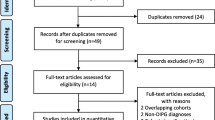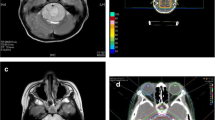Abstract
Purpose
To estimate the rate and magnitude of neurologic symptom change during radiation therapy (RT) and impact of symptom change on survival outcomes in patients with diffuse intrinsic pontine glioma (DIPG).
Methods
From 2006 to 2014, 108 patients with newly diagnosed DIPG were treated with conventionally fractionated radiation therapy (RT) to 54 Gy (median) at our institution. The presence and severity of neurologic symptoms related to cranial neuropathy (CN) and cerebellar (CB) and long-tract (LT) signs was reviewed before and weekly during RT for each patient. The rate and magnitude of change for each symptom category was evaluated according to accumulated RT dose. The impact of clinical factors and radiation dose-volume parameters was determined using Cox proportional hazards models.
Results
Median dose to first sign of symptomatic improvement was 16.2 Gy (CN), 19.8 Gy (LT) and 21.6 Gy (CB). Most patients showed an improvement by 20 Gy. Larger uninvolved brainstem volume, alone or normalized to total brain (TB) or posterior fossa volume (PF), was associated with shorter time to LT sign improvement (P = 0.044, P = 0.033, and P = 0.05, respectively). Patients with any improvement in CN experienced significantly, yet modestly, prolonged progression-free survival (PFS) and overall survival (OS) (P = 0.002 and P = 0.008, respectively). Tumor volume, with or without normalization to TB or PF, was not significantly associated with PFS or OS.
Conclusions
Low cumulative RT doses resulted in neurologic improvement in most patients with DIPG. The volume of brainstem spared by tumor influenced time to symptomatic improvement. Neurologic improvement during RT was associated with superior survival.



Similar content being viewed by others
References
Cooney T, Lane A, Bartels U et al (2017) Contemporary survival endpoints: an International Diffuse Intrinsic Pontine Glioma Registry study. Neuro Oncol 19(9):1279–1280
Donaldson SS, Laningham F, Fisher PG (2006) Advances toward an understanding of brainstem gliomas. J Clin Oncol 24(8):1266–1272
Veldhuijzen van Zanten SE, Cruz O, Kaspers GJ, Hargrave DR, van Vuurden DG, Network SIOPEDIPG (2016) State of affairs in use of steroids in diffuse intrinsic pontine glioma: an international survey and a review of the literature. J Neurooncol 128(3):387–394
Hargrave D, Bartels U, Bouffet E (2006) Diffuse brainstem glioma in children: critical review of clinical trials. Lancet Oncol 7(3):241–248
Whyte TR, Colby MY, Layton DD (1969) Radiation therapy of brain-stem tumors. Radiology 93(2):413–416
Jalali R, Raut N, Arora B et al (2010) Prospective evaluation of radiotherapy with concurrent and adjuvant temozolomide in children with newly diagnosed diffuse intrinsic pontine glioma. Int J Radiat Oncol Biol Phys 77(1):113–118
Hibi T, Shitara N, Genka S et al (1992) Radiotherapy for pediatric brain stem glioma: radiation dose, response, and survival. Neurosurgery 31(4):643–650 (discussion 650–641)
Broniscer A, Baker JN, Tagen M et al (2010) Phase I study of vandetanib during and after radiotherapy in children with diffuse intrinsic pontine glioma. J Clin Oncol 28(31):4762–4768
Broniscer A, Baker SD, Wetmore C et al (2013) Phase I trial, pharmacokinetics, and pharmacodynamics of vandetanib and dasatinib in children with newly diagnosed diffuse intrinsic pontine glioma. Clin Cancer Res 19(11):3050–3058
Wetmore C, Broniscer A, Turner D et al. First-in-pediatrics phase I study of crenolanib besylate (CP-868,596 – 26) administered during and after radiation therapy (RT) in newly diagnosed diffuse intrinsic pontine glioma (DIPG) and recurrent high-grade glioma (HGG). J Clin Oncol 2014; 32(15 suppl):10064
Armstrong TS, Bishof AM, Brown PD, Klein M, Taphoorn MJ, Theodore-Oklota C (2016) Determining priority signs and symptoms for use as clinical outcomes assessments in trials including patients with malignant gliomas: Panel 1 Report. Neuro Oncol 18(Suppl 2):ii1–ii12
Janssens GO, Gidding CE, Van Lindert EJ et al (2009) The role of hypofractionation radiotherapy for diffuse intrinsic brainstem glioma in children: a pilot study. Int J Radiat Oncol Biol Phys 73(3):722–726
Zaghloul MS, Eldebawy E, Ahmed S et al (2014) Hypofractionated conformal radiotherapy for pediatric diffuse intrinsic pontine glioma (DIPG): a randomized controlled trial. Radiother Oncol 111(1):35–40
Helton KJ, Phillips NS, Khan RB et al (2006) Diffusion tensor imaging of tract involvement in children with pontine tumors. AJNR Am J Neuroradiol 27(4):786–793
Helton KJ, Weeks JK, Phillips NS et al (2008) Diffusion tensor imaging of brainstem tumors: axonal degeneration of motor and sensory tracts. J Neurosurg Pediatr 1(4):270–276
Jansen MH, Veldhuijzen van Zanten SE, Sanchez Aliaga E et al (2015) Survival prediction model of children with diffuse intrinsic pontine glioma based on clinical and radiological criteria. Neuro Oncol 17(1):160–166
Hoffman LM, Veldhuijzen van Zanten SEM, Colditz N et al (2018) Clinical, radiologic, pathologic, and molecular characteristics of long-term survivors of diffuse intrinsic pontine glioma (DIPG): a collaborative report from the International and European Society for Pediatric Oncology DIPG Registries. J Clin Oncol 36(19):1963–1972
Massimino M (2015) Study of re-irradiation at relapse versus RT and multiple elective RT courses (DIPG). Clinical Trials.gov Identifier: NCT03620032
Wen PY, Macdonald DR, Reardon DA et al (2010) Updated response assessment criteria for high-grade gliomas: Response Assessment in Neuro-Oncology Working Group. J Clin Oncol 28(11):1963–1972
Macdonald DR, Cascino TL, Schold SC, Cairncross JG (1990) Response criteria for phase II studies of supratentorial malignant glioma. J Clin Oncol 8(7):1277–1280
Nayak L, DeAngelis LM, Brandes AA et al (2017) The Neurologic Assessment in Neuro-Oncology (NANO) scale: a tool to assess neurologic function for integration into the Response Assessment in Neuro-Oncology (RANO) criteria. Neuro Oncol 19(5):625–635
Acknowledgements
The authors would like to thank Keith A. Laycock, PhD, ELS, for scientific editing of the manuscript.
Funding
This work was supported in part by the American Lebanese Syrian Associated Charities (ALSAC), the National Cancer Institute grant P30 CA021765 (St. Jude Cancer Center Support Grant), and the Dunagan MD Medical Education Fund (to K.C.). The content is solely the responsibility of the authors and does not necessarily represent the official views of the National Institutes of Health
Author information
Authors and Affiliations
Corresponding author
Ethics declarations
Conflict of interest
All authors declare that they have no conflict of interest.
Ethical approval
All procedures performed in studies involving human participants were in accordance with the ethical standards of the institutional and/or national research committee and with the 1964 Helsinki declaration and its later amendments or comparable ethical standards. For this type of study formal consent is not required.
Additional information
Publisher's Note
Springer Nature remains neutral with regard to jurisdictional claims in published maps and institutional affiliations.
Electronic supplementary material
Below is the link to the electronic supplementary material.
Rights and permissions
About this article
Cite this article
Tinkle, C.L., Campbell, K., Han, Y. et al. Radiation dose response of neurologic symptoms during conformal radiotherapy for diffuse intrinsic pontine glioma. J Neurooncol 147, 195–203 (2020). https://doi.org/10.1007/s11060-020-03415-w
Received:
Revised:
Accepted:
Published:
Issue Date:
DOI: https://doi.org/10.1007/s11060-020-03415-w




